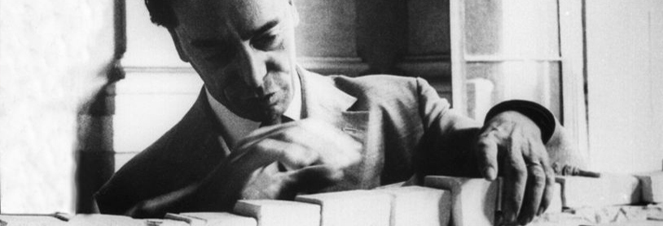Piero Gazzola

Piero Gazzola was born in Piacenza on 6th July 1908, the son of Giovanni Gazzola, a civil engineer. After receiving his high school diploma in Classical Studies, he graduated in 1932 in Civilian Architecture at the Polytechnic University of Milan. Two years later he graduated in Literature and Philosophy at the Università degli Studi di Milano. In 1935 he specialized in Palaeography and Diplomacy, and in 1936 he also received a Specialization Diploma in air raid shelter construction at the Milan Polytechnic.
The studies undertaken during his early life regarded the research and original historical analysis of the architecture and protagonists of the Italian renaissance and baroque movements, as well as fortifications. He would go on to carry out and promote these activities during his twenty years at the Milan Polytechnic University, lecturing in History and Styles of Architecture, Constructive and Stylistic Characteristics of Monuments, and Restoration of Monuments.
After his second graduation, he immediately embarked on a career in the conservation of monuments: at the Soprintendenza all'Arte Medioevale Moderna della Lombardia(Superintendence of Medieval and Modern Art in the Lombardy region) he was first appointed as architect in the department of monuments, excavations, and tunnels. He would later be promoted to the role of Superintendent in Western Sicily (1939-1941), and from 1942 until 1973, he was the head of the Soprintendenza ai Monumenti del Veneto occidentale (Superintendence of the Western Veneto region: the provinces of Verona, Mantova, and Cremona). In the space of just a decade (1946-56), he oversaw 150 restoration sites with the utmost courage and passion, becoming a world-renowned expert in the field of the protection and preserving of monuments and sites of cultural importance.
The skills he acquired during a series of large-scale interventions in monument reconstruction - the most famous of which were the restoration of two historical bridges in Verona (Ponte di Castelvecchio and Ponte Pietra) - lead him to be appointed in 1952 as “Specialiste pour les Monuments, les fouilles archèologiques et les sites d’art et d’histoire” by UNESCO. It is in this role that he gave his own personal technical contribution to the drafting of directives and guidance, coordinating important overseas missions for the development of vast projects supporting some of the world’s most archaeologically and culturally important sites; these include sites in Abu Simbel, Egypt (1959 - 1961), Iraq (1967), Cyprus (1969), Afghanistan (1970), and Peru and Mexico (1971). He garnered particular attention for his international prize-winning project - which would later be realized differently - for the salvage of the Nubian temples.
Throughout the 1960s Gazzola worked tirelessly within a network of international relations for the support of conservation within a collective scope. He both took part in and organized international symposia, and invested in the training of restoration architects, teaching as a visiting professor in Italian and European universities. In addition, within the ICCROM he promoted the launch of international postgraduate courses (in Bangkok, Mexico City, Madrid), similar in nature to the Scuola di Perfezionamento at the University of Rome.
In 1965 he was appointed the first Chairman of the International Council on Monuments and Sites - ICOMOS - an organization he created together with Roberto Pane and Guglielmo De Angelis D’Ossat. He remained Chairman until 1975. He founded the magazine “Castellum”, and acted as Chairman of the Istituto Italiano dei Castelli (Italian Castle Institute, 1964-1974), theIstituto per gli studi storici veronesi (Institute of Historical Studies of Verona), and the Società Belle Arti (Fine Art Society) in Verona. He was also a member of the scientific committee of the CISA, Centro Studi Andrea Palladio (The Andrea Palladio International Centre for Architectural Studies,1959-1979), as well as the board of directors of the Triennale museum in Milan (1964-1973) and of the Ente Ville Venete (1963-1971).
Together with the historian and architect Roberto Pane, Gazzola was also the co-author of the Venice Charter of 1964, the first international document produced in light of postwar reconstructions, after the restoration directives set out in 1931.
The late twentieth century saw a social redefinition of the monument - a part of cultural heritage inextricably linked with the historical evolution of the people - and an entirely new evaluation of the act of conservation on an urban scale; a large part of the credit for this change goes to Gazzola.
In that same period of time, he became one of the experts hired by the European Council for research into new tools for the conservation of “historical town districts”. These included the preparation of the Inventario di protezione del Patrimonio Culturale Europeo (IPCE), the first complete catalogue classifying archaeological, historical, ethnological, and naturalistic assets, produced in order to delineate on a technical basis the sites and works in need of protection throughout the various national territories. At the same time, in Italy, he took on the role of technical inspectorat the Direzione generale Antichità and Belle Arti of the Consiglio Superiore dei Lavori Pubblici (directorate-general of Antiquities and Fine Art at the Supreme Council of Public Works). He received several honours, including the gold medal of merit in culture and art from the Minister of Education, and two honorary degrees.
In 1978 he received the Europa für Denkmalpflege (Stiftung F.V.S. zu Hamburg) prize, an acknowledgment of the “exceptional merit” of his “tireless work and dedication to the diffusion and precise determination of the concept of Denkmalpflege, as well as its realization.
He died in Negrar (Verona) on 14th September 1979.

